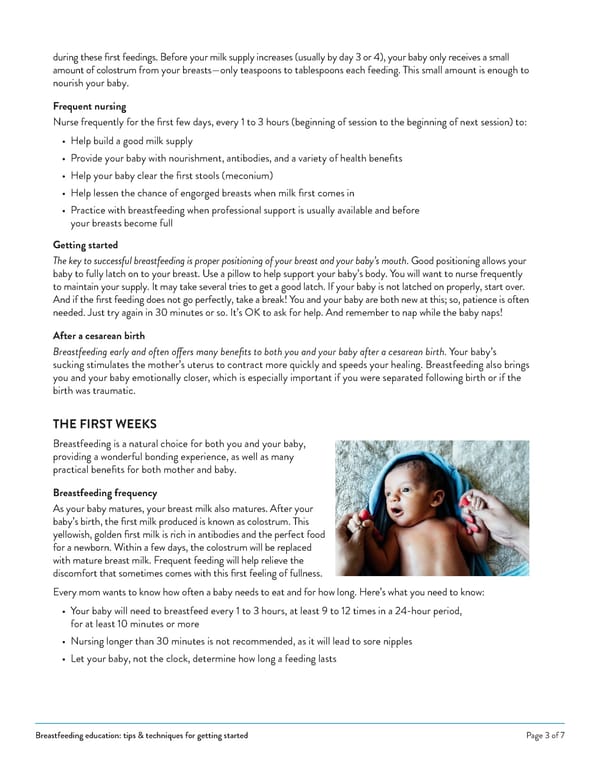during these first feedings. Before your milk supply increases (usually by day 3 or 4), your baby only receives a small amount of colostrum from your breasts—only teaspoons to tablespoons each feeding. This small amount is enough to nourish your baby. Frequent nursing Nurse frequently for the first few days, every 1 to 3 hours (beginning of session to the beginning of next session) to: • Help build a good milk supply • Provide your baby with nourishment, antibodies, and a variety of health benefits • Help your baby clear the first stools (meconium) • Help lessen the chance of engorged breasts when milk first comes in • Practice with breastfeeding when professional support is usually available and before your breasts become full Getting started The key to successful breastfeeding is proper positioning of your breast and your baby’s mouth. Good positioning allows your baby to fully latch on to your breast. Use a pillow to help support your baby’s body. You will want to nurse frequently to maintain your supply. It may take several tries to get a good latch. If your baby is not latched on properly, start over. And if the first feeding does not go perfectly, take a break! You and your baby are both new at this; so, patience is often needed. Just try again in 30 minutes or so. It’s OK to ask for help. And remember to nap while the baby naps! After a cesarean birth Breastfeeding early and often offers many benefits to both you and your baby after a cesarean birth. Your baby’s sucking stimulates the mother’s uterus to contract more quickly and speeds your healing. Breastfeeding also brings you and your baby emotionally closer, which is especially important if you were separated following birth or if the birth was traumatic. THE FIRST WEEKS Breastfeeding is a natural choice for both you and your baby, providing a wonderful bonding experience, as well as many practical benefits for both mother and baby. Breastfeeding frequency As your baby matures, your breast milk also matures. After your baby’s birth, the first milk produced is known as colostrum. This yellowish, golden first milk is rich in antibodies and the perfect food for a newborn. Within a few days, the colostrum will be replaced with mature breast milk. Frequent feeding will help relieve the discomfort that sometimes comes with this first feeling of fullness. Every mom wants to know how often a baby needs to eat and for how long. Here’s what you need to know: • Your baby will need to breastfeed every 1 to 3 hours, at least 9 to 12 times in a 24-hour period, for at least 10 minutes or more • Nursing longer than 30 minutes is not recommended, as it will lead to sore nipples • Let your baby, not the clock, determine how long a feeding lasts Breastfeeding education: tips & techniques for getting started Page 3 of 7
 Breastfeeding education: tips & techniques for getting started Page 2 Page 4
Breastfeeding education: tips & techniques for getting started Page 2 Page 4